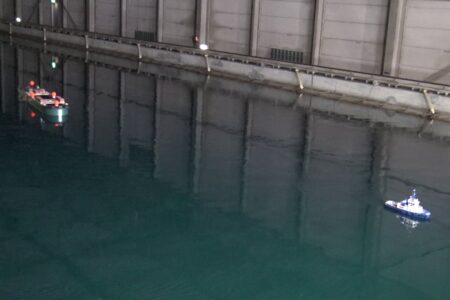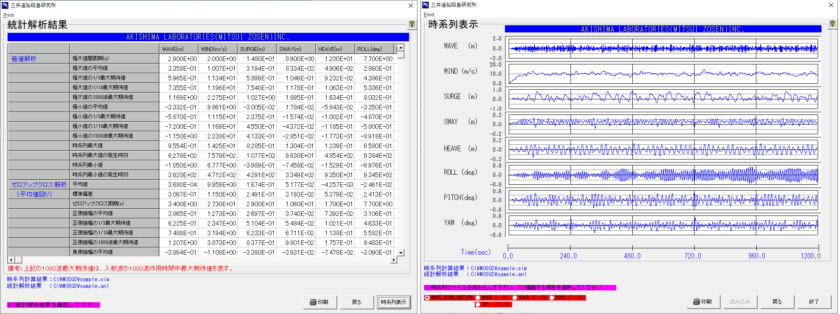We provide technical support for offshore structures such as Floating Production Storage and Offloading (FPSO) and tank tests related to renewable energy, theoretical analysis, and CFD analysis. Leveraging our wide range of experience and knowledge, we help solve marine issues.
Offshore
 We perform motion response calculations and tank tests for offshore structures such as Floating Production, Storage and Offloading (FPSO), and floating offshore wind turbines. We also have the know-how for ultra-large floating bodies such as Mega Float.
We perform motion response calculations and tank tests for offshore structures such as Floating Production, Storage and Offloading (FPSO), and floating offshore wind turbines. We also have the know-how for ultra-large floating bodies such as Mega Float. 
 FPSOs, floating bodies for offshore wind power, non-self-propulsion work ships such as SEP ships, and floating structures such as caissons must be towed to their destinations using tugs. We have the simulation and tank test technology necessary for examining safety issues. We provide our technology for various problems related to towing.
FPSOs, floating bodies for offshore wind power, non-self-propulsion work ships such as SEP ships, and floating structures such as caissons must be towed to their destinations using tugs. We have the simulation and tank test technology necessary for examining safety issues. We provide our technology for various problems related to towing. 
 We can conduct tank tests and numerical analyses for various mooring methods, from quay walls to deep water. We also carry out calculation engineering using in-house developed tools and commercial tools. Utilizing the know-how of fluid dynamics and kinematics that we have cultivated, we help evaluate swing stability and the design of mooring systems.
We can conduct tank tests and numerical analyses for various mooring methods, from quay walls to deep water. We also carry out calculation engineering using in-house developed tools and commercial tools. Utilizing the know-how of fluid dynamics and kinematics that we have cultivated, we help evaluate swing stability and the design of mooring systems. 
 We have developed a system that predicts and calculates the sway of the floating body, the tension of the mooring line, the reaction force of the fender, etc., when a floating body, such as a ship moored to a quay, receives multiple external forces from waves, wind, and tidal currents. The validity of this calculation system has been confirmed in tank experiments, etc., and the analysis results have already been applied to the design of many mooring systems.
We have developed a system that predicts and calculates the sway of the floating body, the tension of the mooring line, the reaction force of the fender, etc., when a floating body, such as a ship moored to a quay, receives multiple external forces from waves, wind, and tidal currents. The validity of this calculation system has been confirmed in tank experiments, etc., and the analysis results have already been applied to the design of many mooring systems. 
● MOSQ2 can be applied to various mooring systems such as multi-point, dolphin, and quay mooring.
● It can create a database for ship-type data other than standard ship-type data (tankers, containers, ferries).
● It can consider long-period waves and fluctuating winds as spectra.
● It can compile the mooring force characteristics of fenders, ropes, chains, etc., into a database.
● It can conduct calculations by considering the non-linear characteristics and hysteresis characteristics of the mooring forces of the mooring device.
● A catenary calculation that considers elongation is incorporated into the program.
● To improve the calculation accuracy of the long-period sway, the influence of memory on the fluid force is considered.
● For quay mooring, reflected waves can be taken into account and calculated even for perpendicular quays.
● Since it is based on a system confirmed by tank tests, highly reliable calculation results can be obtained.
● It is compatible with Windows so that we can input easily with a mouse.
● The output has been processed as graphics, making the results easier to understand.
● It is possible to save animations in avi format.

| Wave | Wave Period, Wave Height, Wave Direction Built-in Spectrum: PM Type (ISSC, Bretschneider-光易), JONSWAP Arbitrary Spectrum can be input |
|---|---|
| Wind | Wind Speed (Steady Wind, Fluctuating Wind), Wind Direction Built-in Spectrum: Davenport, Hino Arbitrary Spectrum can be input |
| Tidal Current | Flow Velocity (steady), Flow Direction |
| Mooring Device | Non-linear and hysteresis characteristics can be considered. Composite ropes can also be handled. |
